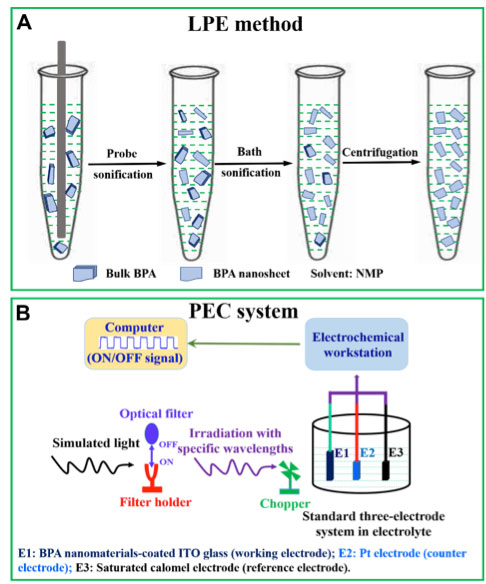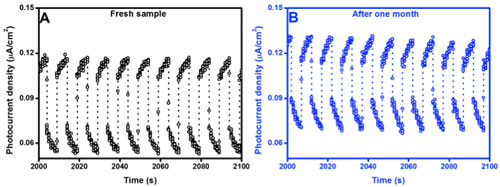| Posted: Mar 14, 2018 | |
Black phosphorus analogues: Emerging photoelectric materials |
|
| (Nanowerk Spotlight) Currently, black phosphorus analogues (BPA) nanoarchitectures, such as bismuthene quantum dots (BiQDs) and bismuth (III) sulfide (Bi2S3) nanosheets, are successfully fabricated by a facile liquid-phase exfoliation (LPE) method. The intriguing photoelectric performance and excellent environmental stability suggest BPA as ideal candidates for photoelectric device absorbers. | |
| Single- or few-layer BP is one of the most promising two-dimensional (2D) semiconductors for electronic and optoelectronic device applications. It has attracted tremendous interest recently, but the environmental instability of BP has always posed a major hurdle for BP-based devices. | |
| BPA materials, on the other hand, not only own the similar folded structure of BP, its tunable bandgap energy band and high carrier mobility, but exhibit excellent environmental stability as well. | |
| Based on that, the significantly improved properties – including photoelectric performance and stability – of BPA-based devices compared to BP-based ones, make them attractive for large-scale applications. | |
| This new research, led by Professor Han Zhang at Shenzhen University in China, has achieved BiQDs and Bi2S3 nanosheets by a facile LPE method, as shown in Fig. 1A below. The typical photoresponse behavior was determined using a PEC measurement with a standard three-electrode system, as shown in Fig. 1B. | |
 |
|
| Fig. 1. (A) A liquid-phase exfoliation strategy to fabricate black phosphorus analogue nanomaterials; (B) a typical PEC system built for evaluating the photoresponse behaviors of the BPA nanomaterials-based photodetector in alkaline solutions. (Image: Dr Huang, Shenzhen University) | |
| PEC results demonstrate that these BPA nanomaterial-based photodetectors exhibit excellent photocurrent signals, self-driven photoresponse behavior and long-term stability of ON/OFF switching behavior in alkaline solutions (Nanoscale, "Facile fabrication and characterization of two-dimensional bismuth(III) sulfide nanosheets for high-performance photodetector applications under ambient conditions" and ACS Photonics, "Ultrasmall Bismuth Quantum Dots: Facile Liquid-Phase Exfoliation, Characterization, and Application in High-Performance UV-Vis Photodetector"). | |
| These findings may open a new avenue for using high-performance BPA in optoelectronics. | |
| In this work, the authors successfully fabricated the BPA nanostructures by a LPE method. The average diameter and thickness of uniformly sized BiQDs are 4.9 ± 1.0 nm and 2.6 ± 0.7 nm, respectively. The size and thickness of as-fabricated Bi2S3 nanosheets range from 40 - 120 nm, 4.2 - 9.9 nm, respectively. | |
| Interestingly, due to the narrow direct band gap of Bi and Bi2S3, both high carrier mobilities, and their relatively high stabilities, the as-prepared BiQDs and Bi2S3 nanosheets can be both used to fabricate high-performance photodetectors. | |
| And surprisingly, both of the BiQDs-based and Bi2S3 nanosheets-based photodetectors exhibit excellent photoresponse and self-driven behavior from the UV to the visible regime in association with long-term stability for on/off switching behavior in alkaline solutions. | |
| We conclude that a higher concentration of KOH electrolyte, higher bias potential, as well as higher light power intensity can lead to higher photocurrent density (Iph) under the illumination of simulated light. | |
| We also note that the applied bias potential provides more impact to the Iph compared to the effects of the KOH concentration under the same illumination. | |
| In addition, we found that the Iph gradually decreases with the increase of wavelength (from 365 nm to 700 nm), mainly resulting from the band gaps or the energy of light. | |
 |
|
| Fig. 2. Stability measurement of photoresponse behavior of BPA nanomaterials-based photodetector in alkaline solutions before (A) and after one month (B). (Image: Dr Huang, Shenzhen University) (click on image to enlarge) | |
| The stability of the photoresponse performance of BPA nanomaterials-based photodetector is crucial for practical applications. To that end, a long test time of 10,000 seconds with intervals of 5 seconds was chosen to investigate the cyclic stability of the photoresponse performance. | |
| An approximate reduction of ~15% of Iph of both (BiQDs and Bi2S3 nanosheets) BPA nanomaterials-based photodetectors was observed when the same sample was measured again after 1 month in alkaline solutions, indicating a good cycling and temporal stability of their photoresponse performances. | |
| In terms of these findings, we anticipate that the LPE-produced BPA nanostructures will find promising potential applications in UV-Visible photodetection as well as liquid optoelectronics. | |
| This work may open up a new way for satisfying the demand for large-scale applications in optoelectronics under ambient conditions. | |
|
Provided by Shenzhen Engineering Laboratory of Phosphorene and Optoelectronics, Shenzhen University, as a Nanowerk exclusive
|
|
|
Become a Spotlight guest author! Join our large and growing group of guest contributors. Have you just published a scientific paper or have other exciting developments to share with the nanotechnology community? Here is how to publish on nanowerk.com. |
|
